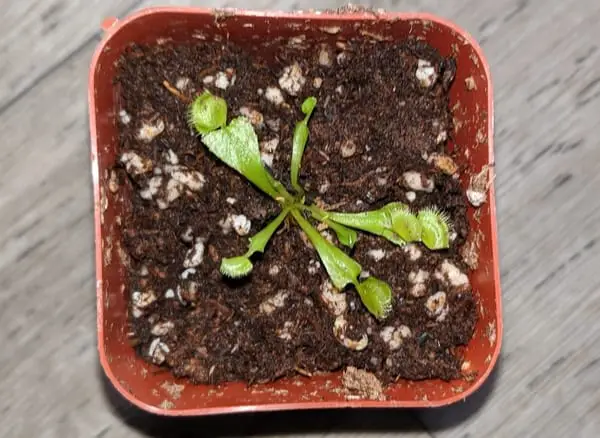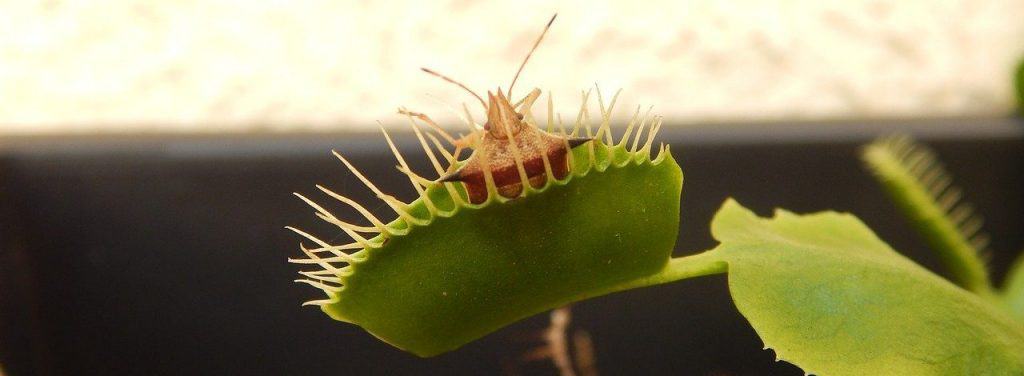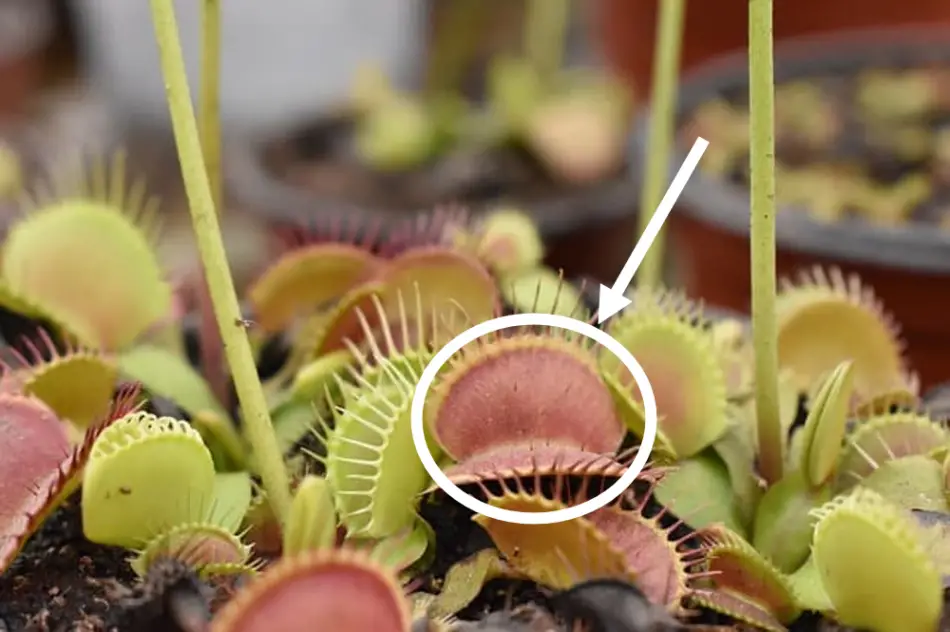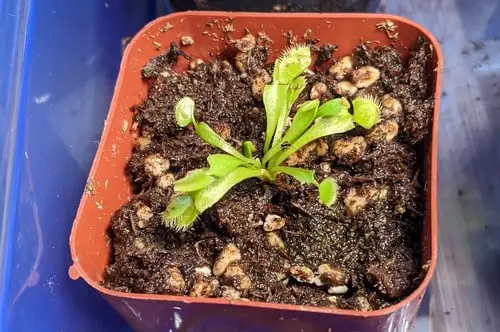Adult Venus flytraps benefit greatly from capturing prey. But, when Venus flytraps are very young, they seem too small to catch bugs. As an owner, you must decide when is the right time to start to feed it.
Baby Venus flytraps have fully functional traps; however, due to their size, it is unlikely they will capture prey. Venus flytrap owners can start feeding their Venus flytrap when the plant develops traps, but feeding young plants is a challenge and can cause leaf loss and stress.
As an owner, you might be excited and ready to feed your Venus flytrap. But, before getting started, you must learn some necessary information. This article will give you tips on how to feed baby or young Venus flytraps.
When Do Venus Fly Traps Start Eating?
Young or baby Venus flytraps, under one-year-old, are very tiny. During the first year, the plant looks exactly like an adult plant, but small. It has defined traps that function. They can open and close upon appropriate stimuli.
Venus flytraps can start eating at a very young age. When they are tiny, they are only capable of eating tiny insects such as ants or gnats. Still, they can capture prey.
Here is a picture of one of my baby Venus flytrap. It is still under a year old. The leaves are open, but only a few mm in length.

The growth of each plant varies in different environments, but usually, as the plant reaches two years of age, the traps will reach a substantial size. At that point, the traps will be about half an inch in length. The leaves will continue to grow in the next months until they reach a size of one inch.
One inch is a mature trap size for Venus flytraps. Venus flytraps can continue to grow horizontally and propagate, but the size of their traps rarely exceeds one inch in length.
Venus flytraps start eating as soon as their traps are large enough to capture prey. And strong enough to hold them captive until the digestion process begins. Venus flytraps must enclose prey completely inside their traps to consume it.

The bug in the picture seems a little too large for the plant. It will most likely escape.
Should You Feed Young Venus Flytrap?
It is a challenge to feed young Venus flytraps due to their size. In the later sections, you will learn how to feed baby Venus flytraps. But, for now, you must first make an assessment. In many cases, it does not make sense to feed a Venus flytrap.
In the wild, Venus flytraps grow in nutrition-less environments. With little or no access to minerals from the ground. As a result, Venus flytraps have developed a bug catching mechanism. They consume bugs to supplement their diet. But, in reality, their food comes from another process: photosynthesis. Like other plants, Venus flytraps produce their own food.
Venus flytraps can live all their life without ever capturing a bug. The nutrients they extract from prey are beneficial but not necessary.
No Venus flytrap, regardless of its age, “needs” bugs to be healthy. It is not recommended to manually feed young Venus flytraps when their traps are smaller than half an inch, as they are delicate and difficult to feed. Instead, the plant can be placed outdoors, with plenty of access to live feed. If the plant is big enough and strong enough to capture prey, it will feed itself.
It is possible to feed a baby or young Venus flytrap, but it is a challenge. The next sections will give you the advice to avoid making crucial mistakes and harming your plant. But be aware that are two alternatives besides manual feeding:
- Let the plant capture its own prey outdoors
- Provide appropriate care to boost the plant’s growth without feeding.`
Proper Care vs Feeding
Venus flytraps benefit from sporadic feeding. A single bug every few weeks can substantially promote the plant’s growth. But, besides feeding, there are other alternatives to stimulate growth.
Proper care ensures the plant is healthy and developing. To promote growth, you must focus on two crucial factors: water and lighting. Photosynthesis is an essential process; boosting it means the plant will be healthy.
Lighting
Venus flytraps require plenty of light. Optimally, they should receive 12 hours of sunlight during the spring. They can live healthy with only 4-6 hours of daylight. But, generally, they prefer sunnier spots. They can be placed under direct or indirect sunlight as long as the plant has exposure to enough sunlight.
Venus flytraps can also live indoors in a sunny window or with access to supplemental lightings, such as plant lights. High output fluorescent lights or LEDs are suitable candidates. These solutions are practical and economical. I use this small plant light (which cost me less than $30) to grow three very healthy Venus flytraps.
Water
Together with lighting, you must also provide appropriate amounts of water. First, Venus flytraps can only be watered with distilled water, reverse osmosis water, or rainwater.
Venus flytraps thrive in humid environments. These plants need to be water constantly. The ground must be moist after watering. Then it can rest for a few days. And when the soil is less humid, water it again.
Besides proper lighting and watering, there are many more care considerations for Venus flytraps. You can download a complete Venus flytrap care sheet from this article: Ultimate Venus Flytrap Care Guide (plus care sheet).
How to Feed a Baby or Young Venus Flytrap
The easiest way to feed a Venus flytrap is to place the plant outdoors. Venus flytraps are effective predators and can capture their own food. Still, in some cases, owners need to take charge of the feeding.
When feeding young or baby Venus flytrap, you have two options: employ live prey or dead prey. Venus flytraps can consume both kinds, but the feeding process varies.
Live Prey Option
If possible, employing live feed is the most effective options.
1.- Obtain suitable prey: You need to employ a live bug that is no larger than 1/3 of the size of the trap you attempt to feed. Wingless fruit flies are a suitable candidate as they are small in size (3/16 inch).
This step is challenging but crucial. Do not attempt to use a large bug. Always select a bug small enough to fit in the trap. If not, the plant will be unable to digest it and end up losing leaves.
2.- Learn about the closing stimuli: Inside each of the lobes in a trap, there are three thin filaments arranged in a triangular pattern. The filaments are commonly called trigger hairs. The leaf closes when something has come in contact with the trigger hairs twice within a short period. The picture below shows the trigger hairs.

3.- After obtaining appropriate food and detecting the trigger hairs, you must place the bug inside the trap and ensure it closes. The trap will close if it receives the stimuli.
There two methods I recommend. First, you can place the bug in the middle of the traps right on top of some of the trigger hairs. I grab the bug with some tweezers and drop in gently. Then, The bug on its own is very likely to produce the stimuli.
The second method is my backup. In this case, I use the same type of bug, but now I employ a thin and soft paintbrush. I place the bug inside the traps and immediately use the paintbrush and make a brushing motion inside the lobes. The trap should close due to the movement.
4.- Observe the trap start the digestion process: Now, the bug will try to escape, but its motion inside the trap will only make things worse. The additional stimuli will activate the special glands inside the leaves. The glands secrete enzymes that drown and digest the prey.
Dead Prey Option
Now let’s learn how to employ dead prey. The video below explains in detail how to feed dead bugs to a Venus flytrap. The video features some adult venus flytraps. It should give you a good idea of the process. Still, you must read the steps below the video for some information specific to young flytraps.
1.- Buy dead prey: Most pet stores and some supermarkets carry dead bug feed. You can choose between dried up crickets, mealworms, or bloodworms. All three are suitable options.
2.- Prepare the bugs: Grind the bugs and add a few drops of distilled water until you obtain a paste. Drain excess moisture if necessary.
3.- Select an appropriate portion: Select a small amount of food that can fit entirely inside the trap. The quantity must not be larger than 1/3 of the size of the trap.
4.- Place the food inside the trap: Use a tool or your hands to lay the food inside the lobes gently. For best results, aim for the center of the trap.
5.- Stimulate the trap to close: Stimulate the trigger hairs inside the traps by touching them with your hand, a paintbrush, or a small tool. Make sure the trap closes.
6.- Continue to stimulate, but from the outside: Once the trap is almost closed, you must continue to stimulate to trick the plant into believing it caught live prey. I suggest using your hands for young Venus flytraps. Even soft tools can damage the plant.
Use your fingers to tap the lobes of the plant together in a pulsing motion. Repeat until the trap is fully closed. It usually takes 30 seconds to a minute of stimulation.
After completing step 6, your plant will start digesting the food.
Live Feed vs Dead Feed
I recommend the live prey option because the leaves of young and baby flytraps are delicate and small. Employing the extra pressure on the leaves when using dead feed can damage them and ending up harming the plant. You must be extremely gentle, and even if you are, the plant can suffer. The live feed option is harmless as long as the bug is the right size.
Besides what you learned in this article there are some additional considerations you must follow when feeding a Venus flytrap. This other article gives you a complete overview of the feeding process: How to Feed a Venus flytrap.


